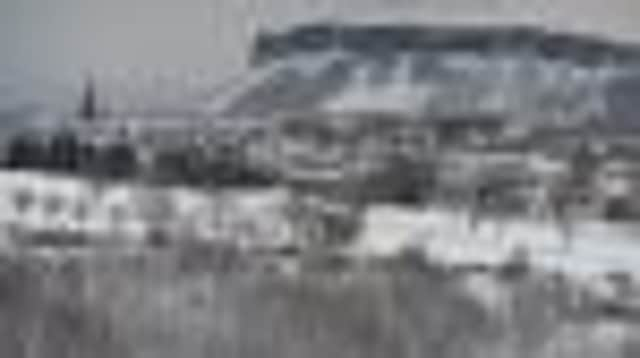Weather: Parts of Scotland set for white Easter


The Met Office said “isolated snow showers” were expected along the east coast this weekend, making it the first white Easter for three years.
However, bookmaker William Hill said the odds of that happening had “drifted”, to 6/4 for Edinburgh and London 3/1.
Advertisement
Hide AdAdvertisement
Hide AdThe Met Office said Scotland may have notched up a record- low Easter weekend temperature, of -10.4C early yesterday in Braemar, 0.6C colder than the previous low, near Aviemore in 1986. It will check records next week.
Forecaster Steven Keates said: “The weather is exceptional, unusually cold and unusually prolonged – with little change next week.
“However, for many, it will be much more settled and brighter this weekend, especially in the north and west of Scotland.”
Records show Kincardineshire, south of Aberdeen, has had its coldest March since 1947, with a mean of 1.5C.
Scotland’s overall mean temperature this month until Tuesday has been 1.6C, the coldest since 1962 and 2.5C lower than average.
However, it has been only 0.4C around Peebles and 0.5C around Selkirk in the Borders – a fraction of the average – and several other areas of Scotland have been hardly any warmer.
Scottish & Southern Energy (SSE) said it hoped to have Arran and Kintyre back on mains electricity supplies by last night after restoring power to the last remaining affected homes using mobile generators during the day.
The firm said engineers had replaced 60 miles of damaged cables since “unprecedented” blizzards blew down ice-covered pylons carrying their mains supply, cutting off 20,000 properties. A further 4,000 affected in Dumfries and Galloway were reconnected earlier in the week.
Advertisement
Hide AdAdvertisement
Hide AdScottish Hydro Power Distribution, part of SSE, said the damage to its pylons, which are up to 100ft high, had been “unprecedented on the British transmission network”. The firm said restoring power following the “catastrophic” damage had been “one of the most complex engineering challenges in its history”.
The work involved six helicopters and a piste basher borrowed from the Glencoe ski centre, with more than 550 engineers and other staff, and the replacement of 350 electricity poles.
Transport minister Keith Brown praised the “outstanding” work done by communities and engineers during the power cuts. He said: “The severe weather over last weekend has created some of the most challenging conditions we have seen in decades. I want to congratulate all those involved in working together to restore, as quickly as possible, normal life for communities across the west of Scotland.”
John Semple, Argyll and Bute’s lead councillor for development and infrastructure, said: “I have been particularly impressed with the way that people have pulled together and rallied round.”
Meanwhile, rural affairs secretary Richard Lochhead yesterday announced £500,000 in aid for farmers whose livestock had died in snowdrifts.
He said: “Tragically, many will have incurred significant losses though the number of dead animals will not be known until the snow has thawed.
“I know this is deeply distressing for farmers to see so many animals suffering and dying, particularly during the lambing season which is normally a season of birth not death.
“We are determined to provide what help and support we can and we will continue to assess what is needed in coming days and weeks.”
Advertisement
Hide AdAdvertisement
Hide AdFirst Minister Alex Salmond yesterday announced the Scottish Cabinet would meet in Campbeltown in August to help promote Kintyre following the bad weather and urged Scots to holiday there.
He said: “I know all of the Scottish ministers are very much looking forward to visiting Campbeltown during the summer and lending our support to a region whose tourist industry has been affected badly by recent extreme weather.”
Questions of Met forecasts
Meanwhile, the Met Office today defended its forecasting after an email emerged showing it had admitted giving the UK Government weather advice that was “not helpful”.
A note uncovered by a freedom of information request from the BBC showed the organisation made the concession after last April became the wettest on record, despite a forecast sent to contingency planners suggesting it was likely to be drier than usual.
Met Office chief scientist Julia Slingo said the long-range forecasts were “probabilistic” and “experimental” and were helpful on around 65 per cent of occasions.
According to the BBC, the three-monthly outlook stated: “The forecast for average UK rainfall slightly favours drier than average conditions for April-May-June, and slightly favours April being the driest of the three months.”
The Met Office memo said: “Given that April was the wettest since detailed records began in 1910 and the April-May-June quarter was also the wettest, this advice was not helpful.”
The prediction was made as part of a three-month forecast that is no longer made public after the Met Office was lampooned for its “barbecue summer” claim ahead of the less than balmy summer of 2009.
Advertisement
Hide AdAdvertisement
Hide AdMs Sligo said: “You have to, of course, with probabilistic forecasts, look over a large number of events and we do that and on about 65 per cent of occasions we do give indeed very helpful advice.
“I think it was quite right that we looked at this particular forecast last year because in March we were facing really very serious pressures on water resources - a major drought that had been going on for nearly a couple of years - and I felt when I looked at the seasonal forecast at that time that I would be not being fair to the government if I didn’t emphasise the fact that we did see a slightly enhanced risk of the drought continuing.
“Likewise, I did also emphasise that there was also quite a chance that April would also be wetter than normal but in the context of where we were at that particular point as a country I felt it was right to emphasise the risk of dry conditions continuing as a precautionary principle.”